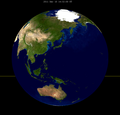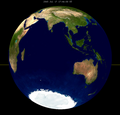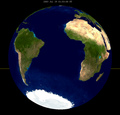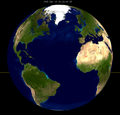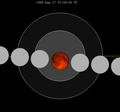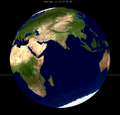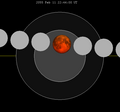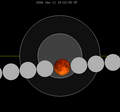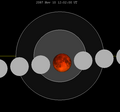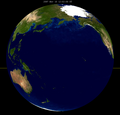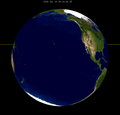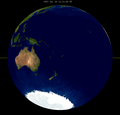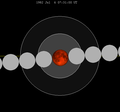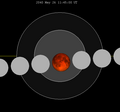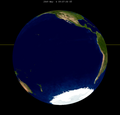June 2011 lunar eclipse
A total lunar eclipse occurred at the Moon’s ascending node of orbit on Wednesday, June 15, 2011,[1] with an umbral magnitude of 1.7014. It was a central lunar eclipse, in which part of the Moon passed through the center of the Earth's shadow. A lunar eclipse occurs when the Moon moves into the Earth's shadow, causing the Moon to be darkened. A total lunar eclipse occurs when the Moon's near side entirely passes into the Earth's umbral shadow. Unlike a solar eclipse, which can only be viewed from a relatively small area of the world, a lunar eclipse may be viewed from anywhere on the night side of Earth. A total lunar eclipse can last up to nearly two hours, while a total solar eclipse lasts only a few minutes at any given place, because the Moon's shadow is smaller. Occurring about 4.1 days after perigee (on June 11, 2011, at 21:40 UTC), the Moon's apparent diameter was larger.[2] The last time a lunar eclipse was closer to the center of the Earth's shadow was on July 16, 2000. The next central total lunar eclipse occurred on July 27, 2018. Visibility and viewingThe eclipse was completely visible over east Africa, Antarctica, and west, central, and south Asia, seen rising over Europe, west Africa, and South America and setting over east Asia and Australia.[3] In western Asia, Australia, and the Philippines, the lunar eclipse was visible just before sunrise.[4] It was very visible in the clear and cloudless night sky throughout eastern and southeast Asia. Africa, far eastern Russia and Europe witnessed the whole event even in the late stages (as in partial lunar eclipse). The Americas (including North and northwestern South America) missed the eclipse completely (except in most areas) because it occurred at moonset.
Images Gallery
Eclipse detailsShown below is a table displaying details about this particular lunar eclipse. It describes various parameters pertaining to this eclipse.[5]
Eclipse seasonThis eclipse is part of an eclipse season, a period, roughly every six months, when eclipses occur. Only two (or occasionally three) eclipse seasons occur each year, and each season lasts about 35 days and repeats just short of six months (173 days) later; thus two full eclipse seasons always occur each year. Either two or three eclipses happen each eclipse season. In the sequence below, each eclipse is separated by a fortnight. The first and last eclipse in this sequence is separated by one synodic month.
Related eclipsesEclipses in 2011
Metonic
Tzolkinex
Half-Saros
Tritos
Lunar Saros 130
Inex
Triad
Lunar eclipses of 2009–2013This eclipse is a member of a semester series. An eclipse in a semester series of lunar eclipses repeats approximately every 177 days and 4 hours (a semester) at alternating nodes of the Moon's orbit.[6] The penumbral lunar eclipses on February 9, 2009 and August 6, 2009 occur in the previous lunar year eclipse set, and the lunar eclipses on April 25, 2013 (partial) and October 18, 2013 (penumbral) occur in the next lunar year eclipse set.
Saros 130This eclipse is a part of Saros series 130, repeating every 18 years, 11 days, and containing 71 events. The series started with a penumbral lunar eclipse on June 10, 1416. It contains partial eclipses from September 4, 1560 through April 12, 1903; total eclipses from April 22, 1921 through September 11, 2155; and a second set of partial eclipses from September 21, 2173 through May 10, 2552. The series ends at member 71 as a penumbral eclipse on July 26, 2678. The longest duration of totality will be produced by member 35 at 101 minutes, 53 seconds on June 26, 2029. All eclipses in this series occur at the Moon’s ascending node of orbit.[7]
Eclipses are tabulated in three columns; every third eclipse in the same column is one exeligmos apart, so they all cast shadows over approximately the same parts of the Earth.
Tritos seriesThis eclipse is a part of a tritos cycle, repeating at alternating nodes every 135 synodic months (≈ 3986.63 days, or 11 years minus 1 month). Their appearance and longitude are irregular due to a lack of synchronization with the anomalistic month (period of perigee), but groupings of 3 tritos cycles (≈ 33 years minus 3 months) come close (≈ 434.044 anomalistic months), so eclipses are similar in these groupings.
Inex seriesThis eclipse is a part of the long period inex cycle, repeating at alternating nodes, every 358 synodic months (≈ 10,571.95 days, or 29 years minus 20 days). Their appearance and longitude are irregular due to a lack of synchronization with the anomalistic month (period of perigee). However, groupings of 3 inex cycles (≈ 87 years minus 2 months) comes close (≈ 1,151.02 anomalistic months), so eclipses are similar in these groupings.
Half-Saros cycleA lunar eclipse will be preceded and followed by solar eclipses by 9 years and 5.5 days (a half saros).[9] This lunar eclipse is related to two annular solar eclipses of Solar Saros 137.
See also
Notes
References
External linksWikimedia Commons has media related to Lunar eclipse of 2011 June 15.
|
|||||||||||||||||||||||||||||||||||||||||||||||||||||||||||||||||||||||||||||||||||||||||||||||||||||||||||||||||||||||||||||||||||||||||||||||||||||||||||||||||||||||||||||||||||||||||||||||||||||||||||||||||||||||||||||||||||||||||||||||||||||||||||||||||||||||||||||||||||||||||||||||||||||||||||||||||||||||||||||||||||||||||||||||||||||||||||||||||||||||||||||||||||||||||||||||||||||||||||||||||||||||||||||||||||||||||||||||||||||||||||||||||||||||||||||||||||||||||||||||||||||||||||||||||||||||||||||||||||||||||||||||||















































